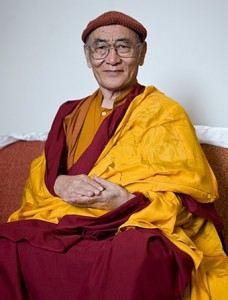The Sakya School of Tibetan Buddhism
The scholar and authoritative teacher of Tibetan Buddhism Lama Jampa Thaye was in Bristol at the weekend teaching original texts from the Sakya lineage. The Sakya school is one of the least known but spiritually and intellectually rich of the four main traditions that have come to the West from Tibet.
Vajrayana Buddhism – Dispelling Myths
People came from across the UK to hear Lama Jampa speak about the final chapter of his book Rain of Clarity which covers the highest levels of practice: the Vajrayana. With particular emphasis on dispelling misunderstandings about the function, transmission and application of this profound spiritual path, Lama Jampa’s talk was greatly appreciated. This is because Buddhists who live in the West may not have received as much education in these matters as those who have grown up within Buddhist cultures.
Rain of Clarity – The Stages of the Buddhist Path in the Sakya Tradition
As with the Buddhist path itself, Lama Jampa’s book begins with a chapter on the act of taking refuge in the three jewels, followed by a chapter on the commitment of bodhichitta – to become a Buddha for the benefit of all beings. This is where one becomes a Mahayana (Great Vehicle) Buddhist. An overview of the practices by which one develops wisdom and compassion take up the next chapter. In the penultimate chapter, Lama Jampa presents a concise introduction to the philosophical view of Madhyamaka that underpins both these perfection practices and those of the Vajrayana. The chapter looks first at the history of this philosophical view from the beginning of the common era in India to its transmission within Tibetan Buddhism. The final chapter on Vajrayana begins with a discussion of the transmission of the teachings, their relationship to the other vehicles of Buddhism, its special characteristics, the different levels of practice and the means of entering into it.
The Importance of Buddhist Lineage and Transmission
One of the recurring themes of the book is the importance of knowing and understanding where the teachings have come from and how they have been transmitted to the present day. Lama Jampa Thaye is one of the very few Westerners with the ability to set out this information and the authority to transmit the actual teachings from the Tibetan lineages he has trained in. The two forewords to the book are evidence of his authority and importance to the transmission of Buddhism to the West: the first being by His Holiness the 41st Sakya Trizin and the second by Karma Thinley Rinpoche , grand master of both the Sakya and Kagyu schools of Tibetan Buddhism. Karma Thinley Rinpoche is the teacher with whom Lama Jampa himself took refuge in 1972, and who appointed him as his regent (spiritual representative) in the UK in 1977.
Entering the Vajranaya Path Through Initiation
In the afternoon those who were committed Buddhists and who wished to practice the Vajrayana, or were already practitioners of it, were able to receive an initiation of Hayagriva. The practice of Hayagriva can help overcome both mental and physical disorders.
Dedicating the Merit to the Benefit of all Beings
At the close of the day on Saturday, Lama Jampa reminded the audience of the great good fortune of encountering these wonderful teachings and receiving what is needed to practice. The day ended with the recitation of the long dedication of merit. This is the commitment of all practices to the achievement of liberation for the benefit of all beings, the heart of the Mahayana Buddhist path (A recording of this is attached).
Listen to the Dedication of Merit here





